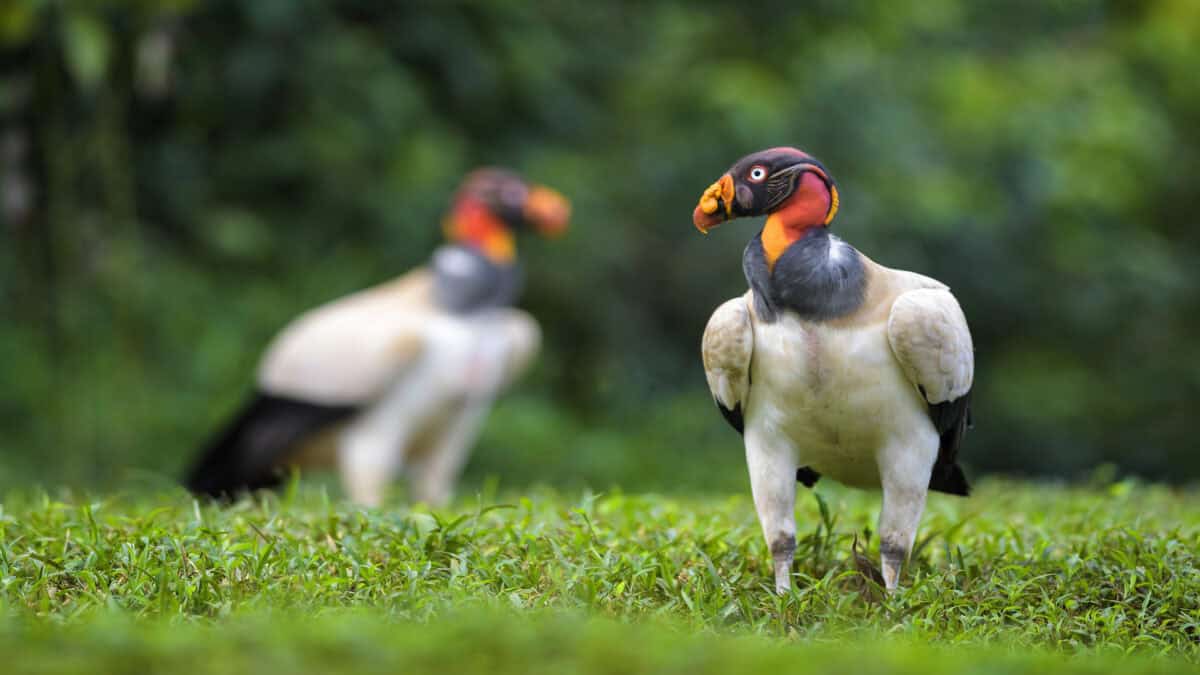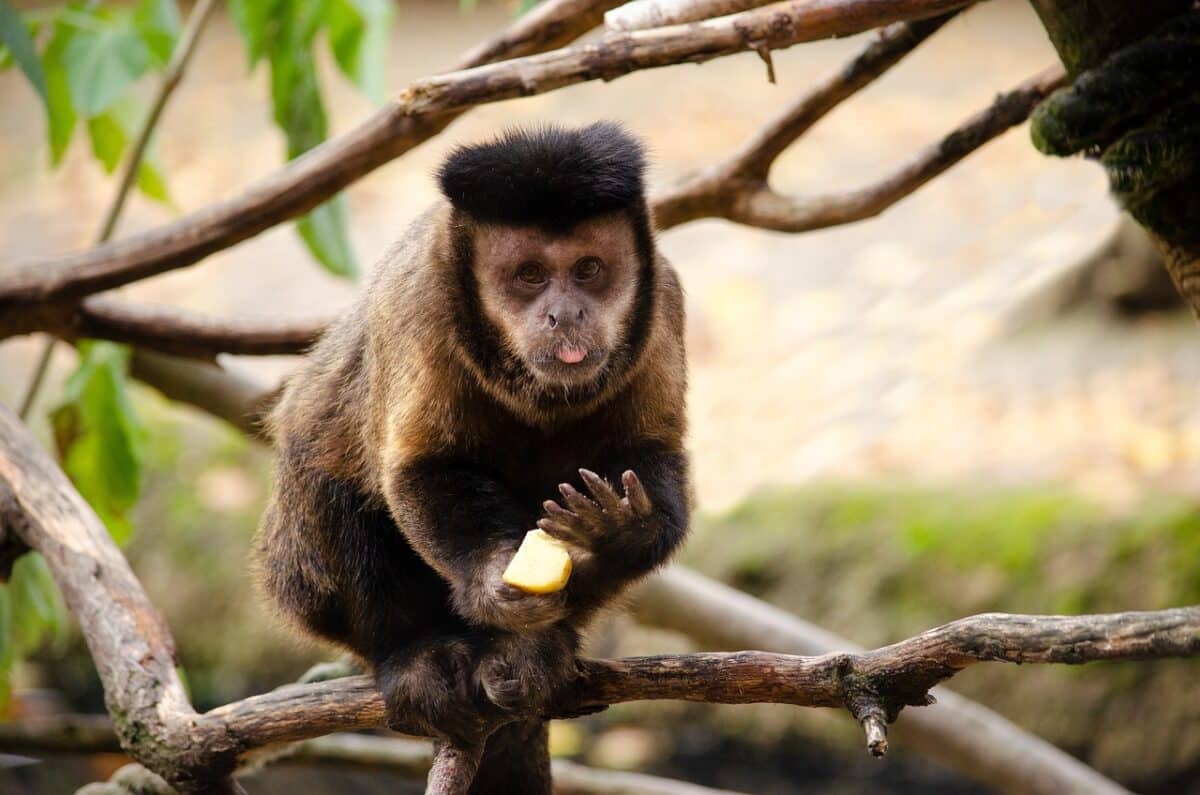For centuries, humans have prided themselves on being the only species to create and use tools. We’ve defined our evolution and progress through our ability to manipulate objects to accomplish tasks beyond our natural physical capabilities. However, as science advances, we’ve discovered that tool use isn’t uniquely human. Across the animal kingdom, numerous species have demonstrated remarkable ingenuity in creating and using tools to solve problems, gather food, and protect themselves. This article explores 14 remarkable animals that have been observed using tools in ways that parallel human behavior, challenging our understanding of animal intelligence and blurring the lines between human and animal cognition.
Chimpanzees Our Closest Tool-Using Relatives

Chimpanzees are perhaps the most famous non-human tool users, and for good reason. These great apes share approximately 98.7% of their DNA with humans and demonstrate some of the most sophisticated tool use in the animal kingdom. Jane Goodall’s groundbreaking observations in the 1960s forever changed our understanding of chimp behavior when she witnessed them stripping leaves from twigs to create “fishing sticks” for extracting termites from mounds. Since then, researchers have documented chimpanzees using stones as hammers and anvils to crack nuts, fashioning spears for hunting, using leaves as cups for drinking water, and even creating leaf sponges to extract water from tree hollows. Perhaps most impressively, different chimpanzee communities have unique tool traditions that are passed down through generations, creating what anthropologists call “cultural transmission” – a trait once thought to be uniquely human.
Orangutans Forest Engineers

Orangutans, with their remarkable intelligence and problem-solving abilities, are sophisticated tool users both in the wild and captivity. These great apes have been observed using sticks to extract seeds from fruits and insects from tree bark. They also fashion umbrella-like covers from large leaves during tropical downpours and construct complex sleeping nests each night by weaving together branches and foliage. In captivity, orangutans have demonstrated even more impressive tool use, learning to use hammers and nails, untie complex knots, and even attempt to pick locks with found objects. One famous orangutan named Fu Manchu at the Omaha Zoo regularly escaped his enclosure using a piece of wire he hid in his mouth and used to pick the lock on his cage. What makes orangutan tool use particularly remarkable is that unlike chimpanzees, orangutans are primarily solitary animals, meaning they likely develop these skills through individual learning rather than social observation.
Crows and Ravens Feathered Geniuses

Corvids—particularly crows and ravens—possess some of the most impressive tool-making abilities in the animal kingdom, rivaling those of primates despite having vastly different brain structures. New Caledonian crows are the standout stars, crafting tools with a sophistication that has astounded researchers. These birds carefully select specific plant materials to create hooks and serrated edges for extracting insects from tree crevices. They modify twigs and leaf stems into various shapes for different tasks and even store their favorite tools for future use. In laboratory settings, crows have solved complex multi-step problems that require using tools in sequence. One famous experiment showed a crow named Betty spontaneously bending a straight wire into a hook to retrieve food—a demonstration of mental flexibility previously unseen in non-primates. American crows have been observed dropping nuts onto busy intersections, waiting for cars to crack them open, then retrieving the exposed meat when traffic lights stop vehicles—displaying an understanding of both tool use and traffic patterns.
Bottlenose Dolphins Marine Tool Innovators

Bottlenose dolphins have developed a fascinating tool-using behavior that showcases their problem-solving abilities. In Shark Bay, Australia, researchers have documented a group of dolphins that wear marine sponges on their beaks (rostrums) while foraging on the seafloor—a behavior known as “sponging.” The dolphins carefully uproot conical marine sponges and wear them like protective gloves, allowing them to probe the rough, sandy bottom for fish without injuring their sensitive snouts. What makes this behavior particularly remarkable is that it appears to be culturally transmitted, primarily from mother to daughter, creating a tradition that has persisted for generations. Only certain dolphin family lines practice sponging, suggesting it’s a learned behavior rather than an instinctive one. Researchers believe this represents one of the clearest examples of material culture and tool use in marine mammals. Additionally, dolphins have been observed using shells to herd fish and even using dead fish as bait to attract seagulls, which they then catch and eat—demonstrating remarkable cognitive flexibility in their approach to acquiring food.
Sea Otters Toolkits for Shellfish

Sea otters are one of the few marine mammals known to use tools, and they’ve incorporated tool use into their daily survival routines. These charismatic animals use rocks as hammers to crack open hard-shelled prey like clams, mussels, and sea urchins. What’s particularly fascinating is that individual otters often have favorite rocks they’ll keep with them, storing them in loose pouches of skin under their forelimbs as they swim. Some sea otters become so attached to their preferred tools that they’ll carry the same rock for years. Research has shown that mother otters actively teach their pups how to use rocks as tools, demonstrating different techniques depending on the type of shellfish being targeted. Sea otters also use large, flat rocks as anvils, placing them on their chests while floating on their backs and then smashing shellfish against them. This sophisticated tool use is critical to their survival, as sea otters need to consume approximately 25% of their body weight daily to maintain their metabolic rates in cold coastal waters. Their tool use represents a remarkable example of how animals can develop technological solutions to environmental challenges.
Elephants Gentle Giants with Tools

Elephants boast not only the largest brains of any land animal but also remarkable dexterity with their trunks, enabling sophisticated tool use. These highly intelligent pachyderms have been observed using branches as fly swatters, scratching tools, and even as weapons when threatened. In both wild and captive settings, elephants demonstrate an understanding of tool modification, trimming branches to appropriate sizes for specific tasks. During droughts, elephants dig wells using their trunks, feet, and sometimes tools like sticks to access underground water sources. Once they’ve created these wells, they’ve been observed using chewed bark as a kind of “filter sponge” to extract clean water. Asian elephants in captivity have demonstrated even more impressive tool-using capabilities, learning to use sticks to reach otherwise inaccessible objects and even painting with brushes when trained. Perhaps most remarkably, researchers have documented elephants in multiple regions using large rocks to plug water holes they’ve dug, apparently to prevent evaporation and preserve their water source—showing forethought and planning that extends beyond immediate problem-solving.
Octopuses Eight-Armed Tool Masters

Octopuses represent a fascinating case of convergent evolution when it comes to intelligence and tool use, having developed these traits independently from vertebrates through an entirely different evolutionary path. These remarkable cephalopods have been observed collecting and using coconut shells as portable shelters in areas where natural protection is scarce. Veined octopuses in Indonesia gather coconut half-shells discarded by humans, clean them out, and carry them across the ocean floor. When threatened, they can rapidly assemble these shells into a spherical protective enclosure. This behavior is considered true tool use because the octopuses transport the shells specifically for future use, showing planning and foresight. Octopuses also use rocks to block the entrances to their dens when they need protection and have been documented using sticks to poke at potentially dangerous objects. In laboratory settings, they’ve solved complex puzzles requiring multiple steps, opened childproof medicine bottles, and even learned to unscrew jar lids to access food rewards. What makes octopus tool use especially remarkable is that they achieve this level of problem-solving with a nervous system dramatically different from mammals, suggesting that intelligence and tool use can evolve through different neurological pathways.
Egyptian Vultures Rock-Throwing Specialists

Egyptian vultures have developed a specialized tool-using technique that showcases their problem-solving abilities. These raptors are one of the few bird species that regularly use tools in the wild, having evolved a unique method for accessing a highly nutritious food source – ostrich eggs. The thick shells of ostrich eggs are too hard for the vultures to break with just their beaks, so they’ve developed a remarkable solution: using rocks as hammers. Egyptian vultures search for appropriately sized stones, pick them up in their beaks, and repeatedly throw them down onto ostrich eggs until the shell cracks open. This behavior requires significant coordination and an understanding of cause and effect. What’s particularly interesting is that this tool use appears to be innate rather than learned – young vultures raised in captivity without ever seeing the behavior will spontaneously attempt to use stones to break open eggs or egg-like objects. This suggests that unlike some other animals whose tool use is culturally transmitted, Egyptian vultures may have this behavior genetically encoded. Some vultures have even been observed using hard objects like bones when stones aren’t available, showing flexibility in their approach to problem-solving.
Gorillas Unexpected Tool Users

For many years, gorillas were thought to be the only great ape that didn’t use tools in the wild, despite their close genetic relationship to humans. However, recent research has upended this assumption. Wild gorillas have now been documented using sticks to test water depth before crossing streams and employing branches as walking sticks for support when navigating unstable terrain. In 2005, researchers observed western gorillas in the Congo using sticks as simple measuring tools to test the depth of marshy terrain and as support when reaching for aquatic plants. Female gorillas have been seen using sticks as a form of tool to help extract food, and others have used tree trunks as bridges to cross wet areas. In captivity, gorillas demonstrate even more advanced tool use, using sticks to retrieve out-of-reach food, rocks to crack nuts, and even makeshift ladders to escape enclosures. One particularly famous case involved Koko, a western lowland gorilla who learned sign language; she was observed using a sink as a tool for directing water into a cup for drinking. While gorilla tool use may be less frequent and less sophisticated than that of chimpanzees or orangutans, these observations challenge earlier assumptions and suggest that tool use may be a more fundamental trait among great apes than previously recognized.
Capuchin Monkeys Skilled Stone Tool Users

Capuchin monkeys have deservedly earned a reputation as the tool-using champions among New World monkeys. These intelligent primates have been observed using stones as hammers to crack open nuts, seeds, and shellfish across their range in Central and South America. What’s particularly impressive about capuchin tool use is the level of sophistication they’ve developed. In Brazil’s Serra da Capivara National Park, groups of bearded capuchins select specific stones based on weight and material properties, transport them to designated anvil sites, and position nuts carefully before striking them with precise aim. They’ve even been observed using stone hammers to pulverize seeds into powder and using sticks as probes to extract insects or honey from crevices. Research has revealed that capuchins have been using stone tools for at least 3,000 years, leaving behind archaeological evidence similar to early human tool use. Young capuchins learn these skills through years of observation and practice, with tool-using proficiency not fully developing until they’re 5-8 years old. In captivity, capuchins demonstrate even more impressive tool innovations, using sticks as levers, sponges as cleaning tools, and even fashioning primitive spears in some instances. Their tool use is particularly notable because it evolved independently from that of Old World primates like chimpanzees, representing a case of convergent evolution of technological behavior.
Archerfish Nature’s Sharpshooters

Archerfish demonstrate one of the most remarkable examples of tool use among fish species, having evolved a sophisticated biological mechanism for hunting that qualifies as true tool use. These remarkable fish, native to brackish waters of Southeast Asia and Australia, have specialized mouths that allow them to shoot down insects and other small prey from overhanging vegetation by firing precisely aimed jets of water. The archerfish forms its mouth into a tube-like structure and contracts its gill covers to force a powerful stream of water that can knock insects off branches up to 10 feet above the water’s surface. What makes this qualify as tool use is that the archerfish is manipulating water—an external element—as a projectile weapon. The cognitive abilities behind this behavior are equally impressive. Archerfish must account for refraction (how light bends when passing from air to water), calculate trajectory, and adjust the force of their water jet based on the target’s distance. Recent research has shown that archerfish can learn to hit moving targets and can even recognize specific human faces, suggesting sophisticated visual processing abilities. Young archerfish aren’t born with perfect shooting skills but must practice and refine this technique, with accuracy improving dramatically with experience—similar to how humans must practice to develop tool-using proficiency.
Woodpecker Finches Nature’s Carpenters

The woodpecker finch of the Galápagos Islands represents one of the most studied examples of tool use among birds and played a significant role in Charles Darwin’s development of evolutionary theory. Unlike true woodpeckers, these small birds lack the specialized anatomy for drilling into wood. Instead, they’ve evolved an ingenious workaround: using twigs, cactus spines, and small sticks as tools to extract insects from tree crevices. The woodpecker finch carefully selects an appropriate twig, sometimes modifying it by trimming leaves or breaking it to the proper length, then uses it as a probe to drive hidden insects out of their hiding places or impale them for extraction. This remarkable adaptation allows the finch to access food sources that would otherwise be unavailable to a bird of its size and structure. Research indicates that woodpecker finches can spend up to half their feeding time using tools, extracting up to 50% of their insect diet through this method. Particularly during dry seasons when insects are scarce in exposed locations, this tool use becomes critical to their survival. What makes the woodpecker finch particularly interesting is that, unlike many tool-using species, they develop this behavior primarily through individual learning rather than social observation. Young finches appear to have an innate tendency to manipulate objects, which gradually develops into full tool use through practice and reinforcement—a fascinating example of how genetic predisposition and individual learning can combine to produce complex behaviors.
Japanese Macaques Cultural Tool Innovators

Japanese macaques, also known as snow monkeys, provide one of the best-documented cases of cultural transmission of tool use in non-human animals. In the 1950s, researchers observed a young female macaque named Imo on Koshima Island washing sweet potatoes in a freshwater stream to remove sand before eating them—a behavior never before seen in these monkeys. This innovation spread rapidly through the troop, first to her peers and family members, then to the entire group. Later, Imo developed an even more sophisticated technique: washing the potatoes in saltwater, which not only cleaned the food but enhanced its flavor with salt. This behavior also spread through cultural transmission. Beyond food washing, Japanese macaques have been observed using stones to play with and manipulate objects, using sticks as probes, and even using water as a tool by developing a technique of separating wheat from sand by throwing the mixture into water—the wheat floats while the sand sinks. The Koshima macaques demonstrate how tool use can arise through individual innovation and then spread culturally through a population, creating local “traditions” that differ between troops. This process mirrors aspects of human cultural evolution and technological development, where innovations spread through social learning rather than genetic inheritance.
Beavers Nature’s Engineers

Beavers represent one of nature’s most impressive examples of animals that modify their environment using sophisticated construction techniques. While their dam-building behavior is often described as instinctive rather than true tool use, beavers demonstrate many characteristics that blur the line between innate construction behavior and tool utilization. These industrious rodents select specific trees to cut down based on size, species, and proximity to water, effectively using their strong teeth as cutting tools. They then process these trees into various sizes for different construction purposes—longer branches for structural support, smaller sticks for filling gaps, and mud and stones for reinforcement. Beaver dams involve complex engineering, with underwater entrances, multiple chambers.
Conclusion:

The remarkable diversity of tool use across the animal kingdom challenges long-standing assumptions about what sets humans apart from other species. From chimpanzees crafting termite fishing sticks to crows bending wire into hooks, and from dolphins using sponges to octopuses building portable shelters, these behaviors reveal a shared capacity for innovation, learning, and problem-solving. Some species pass on tool traditions through culture, while others independently develop techniques through instinct and trial-and-error—mirroring the evolutionary roots of human ingenuity. As we continue to uncover the complexity of animal intelligence, it becomes increasingly clear that the ability to use tools is not a uniquely human trait, but rather a widespread and diverse strategy that has evolved independently across taxa. This growing body of evidence invites us to rethink the boundaries of cognition and recognize that intelligence, in all its forms, is far more common in the natural world than we once believed.
- 10 Common Chicken Behaviors and What They Mean - August 9, 2025
- 14 Creatures That Can Freeze and Thaw Back to Life - August 9, 2025
- 10 Animals That Risked Their Lives to Save Humans - August 9, 2025

